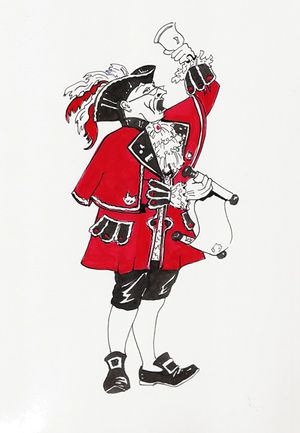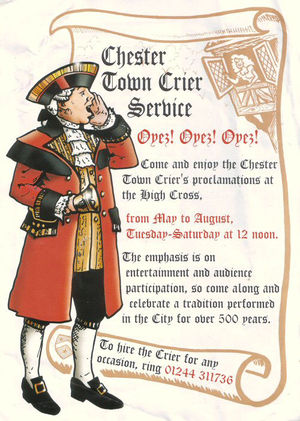Town Crier
Contents
Historical Sketch on Town Crier
Town criers could well be described as “historical newscasters”. It is known that the tradition was started in ancient Greece, when heralds were used to announce the severing of relationships which would lead to an official proclamation of war. The herald would also be used to bear proposals of truce or armistice.
The origin of the word “stentorian” has been attributed to the Greek warrior Stentor, who played a part in the Trojan war and whose voice was said to be as powerful as the voices of 50 other men. The first use of criers in the British Isles was said to date back to Norman times, when the cry “oyez, oyez, oyez”, (old French for “hear ye”) was used to draw the attention of the mostly illiterate public to matters of importance.
As town criers enjoyed royal protection, the command “don’t shoot the messenger” had very real significance. In the capital city of Edinburgh, one of the last known town criers was George Pratt – about the year 1784 – who was noted for his pompous delivery in discharging his duties. George had a high opinion of the importance and dignity of his situation as a public officer. They persecuted him with the cry of “quack, quack!” – a monosyllable which was particularly offensive to his ears. This cry was sometimes varied into “swallow’s nest”, a phrase which he also abominated, as it made an allusion to a personal deformity – a large wen that grew beneath his chin.
Although we have access to many different, almost instant, types of communication these days there is still a place for “communication with a human face”. Town criers are used to lead parades, open supermarkets, launch ships, attend official functions and act as ambassadors of good will on any occasion when a flamboyantly dressed character can be deployed to draw attention to what is happening. Criers or bellmen were usually people of some standing in the community, as they had to be able to read and write the proclamations. The crier would read a proclamation, usually at the door of the local inn, then nail it to the door post – which is where the expression “posting a notice” comes from, as well as naming newspapers as the post.
The Medium is NOT the message
Hermes, the fleet-footed messenger with wings on his heels and cap symbolizes fast floral delivery. However, Hermes was originally neither winged nor a messenger - that role was reserved for the rainbow goddess Iris. He was, instead, clever, tricky, a thief, and, with his awakening or sleep-conferring wand, the original sandman whose descendants include a major Greek hero and a noisy, fun-loving god.
In the Iliad, Iris is the messenger god and in the Odyssey, it's Hermes, but even in the Iliad (Book 2), there is a passage where in the words of Timothy Ganz, Hermes serves as courier:
"Then King Agamemnon rose, holding his sceptre. This was the work of Vulcan, who gave it to Jove the son of Saturn. Jove gave it to Mercury, slayer of Argus, guide and guardian. King Mercury gave it to Pelops, the mighty charioteer, and Pelops to Atreus, shepherd of his people. Atreus, when he died, left it to Thyestes, rich in flocks, and Thyestes in his turn left it to be borne by Agamemnon, that he might be lord of all Argos and of the isles."
In this sense, town criers have been took their role as Hermes and then were used to issue warnings and acted as conveyors of local news. In Haddington, East Lothian, after a fire which destroyed one side of the High Street in 1598, the “coal and candle” proclamation was introduced. This was an instruction to the burghers to acquaint themselves with every device for fire prevention. The proclamation was announced by the town crier nightly except Sunday from Martinmas to Candlemas.
Isn’t it still “Alive”? Pops and hisses: Cyborg as Double-Headed figures
From the perspective of audience, there are no more people those who are just dependent on what town criers – on the material level – are saying. If so, I would like to deploy the networks of information in terms of players.
When technologies comes to us, people need to examine how they came to get their knowledge and advocate self-examination to identify possible biases so that individuals can avoid believing in “unlocatable, and so irresponsible, knowledge claims” not just being dependent on messengers who let us know what is happening. (Haraway, Situated Knowledges 583). Reiterating the importance of acknowledging one’s hybridism, she emphasizes the danger of acquiring knowledge from only one source: “the moral is simple: only partial perspective promises objective vision” (583). She encourages objectivism, deconstruction, partiality and critical interpretation. Her insistence that partial perspectives must be used to build situated knowledge is reflective of her construction of the hybrid-cyborg: The knowing self is partial in all its guises, never finished, whole, simply there and original; it is always constructed and stitched together imperfectly, and therefore able to join with another, to see together without claiming to be another (586).
The cyborg is a utopian figure that is representative of a possible world-view and a political figure that Haraway wants women to embrace and “code”. However, the cyborg is also dangerous. In the same way that cyborgs build networks of affinities with no beginning and no end, they also represent networks of communication that can exert control with no beginning and no end. The irony that the cyborg figure embodies both of these optimistic and terrible possibilities is one of the more challenging concepts within A Manifesto For Cyborgs. Haraway believes that it is impossible to escape the cyborg as a site of contestation (Penley et al 13). The challenge, she believes, is to “see from both perspectives at once because each reveals both dominations and possibilities unimaginable from the other vantage point” (Haraway, A Manifesto For Cyborgs 154). That is, in order to embrace the metaphor of the cyborg as a way to build coalitions and value partial identities, one must be prepared to recognize the dangers of this mythical figure. The dangers arise when we stop contesting the boundary definitions of human and animal, organism and machine; without such contestation, biological and technological determinism will prevail.
Where do media go to die?
We can say that town crier does not work anymore, but we can see it as remediated forms in daily routine life as the technology used is in a very literal sense extinct. Unless there are definitely monumental leaps regarding the historical newscasters, there are no more town criers. On the aspect of media, what are the necessities of a media that degrade the long term utility of the media itself, or of the social conditions that cause its use? In the case of town criers, it is pretty hard to being existed. Due to ‘pop and hiss’, town criers are unnecessary at the material level but are still nevertheless necessary at the semiotic level. We are still eager to know how newscasters probe the fact with their own situated knowledge.
References
- Donald, Kelley R. ".Hermes, Clio, Themis: Historical Interpretation and Legal Hermeneutics." The Journal of Modern History, 55(4),644-668
- Haraway, Donna. "Situated Knowledge:The Science Question in Feminism and the Privilege of Partial Perspective." Feminist Studies,14(3),1988. 575-599.
- Haraway, Donna. "A Cyborg Manifesto: Science, Technology, and Socialist-Feminism in the Late Twentieth Century," in Simians, Cyborgs and Women: The Reinvention of Nature (New York; Routledge, 1991),149-181.


